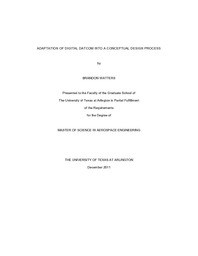
ATTENTION: The works hosted here are being migrated to a new repository that will consolidate resources, improve discoverability, and better show UTA's research impact on the global community. We will update authors as the migration progresses. Please see MavMatrix for more information.
Show simple item record
| dc.contributor.author | Watters, Brandon | en_US |
| dc.date.accessioned | 2012-04-11T21:00:04Z | |
| dc.date.available | 2012-04-11T21:00:04Z | |
| dc.date.issued | 2012-04-11 | |
| dc.date.submitted | January 2011 | en_US |
| dc.identifier.other | DISS-11492 | en_US |
| dc.identifier.uri | http://hdl.handle.net/10106/9645 | |
| dc.description.abstract | As implied with open-ended `design decision-making' there are multiple prospective conventional and unconventional aircraft solution concepts able to satisfy a given mission specification. The task of defining, assessing and selecting prospective options for the mission at hand is the primary purpose of the aircraft conceptual design (CD) phase. In addition, conceptual design tends to be fast paced and an iterative process structure that requires a quick design-response. This leads the aircraft designer to simplified analysis techniques that focus on the impact (trends and sensitivities) of a new technology on the design. Correctly predicting these trends and sensitivities can be difficult. Furthermore, if these trends and sensitivities are correctly predicted there will not be one solution to a given mission, which makes this an open-ended problem and the CD process abstract. The Aerospace Vehicle Design Laboratory (AVD Lab) has developed the Aerospace Vehicle Design Synthesis (AVDS) process to support early fact based decision making. The AVDS process contains a methods library and a process library that are utilized in conjunction with each other to represent a design. The focus of this thesis is placed on adding aerodynamic capability to the AVDS process in the context of the methods library and process library. Different aircraft configurations and flight regimes make the evaluation of aircraft con-cepts for a single tool difficult. Often time's method applicability becomes an issue. There are many aerodynamic methods to choose from with different capabilities and requirements. Digital DATCOM is a tool with a vast self-contained methods library but is restricted to a set of aircraft configuration concepts due to its process of methods switching. The methods available in DATCOM can be applied to a wider range of aircraft configuration concepts than Digital DATCOM allows because of this process. Presented here is an adaptation of Digital DATCOM named DATCOM MAX. MAX because the tool is now capable of producing aerodynamic contributions of aircraft components and control surfaces in a CD environment for an expandable set of configuration concepts. A B747-200F case study was chosen because of the richness of the information available about this aircraft. First DATCOM MAX is verified to match Digital DATCOM, using the B747-200F model. Then the correctness of the DATCOM methods are verified against published experimental aerodynamic data for the B747-200F. A user's manual was also produced with the code that provides a platform to add capability to DATCOM MAX in the future.The research presented is a step taken to expand the capability of the AVDS methods library in the area of aerodynamics by removing some process dependency of Digital DATCOM. The objective is to create a tool capable of producing a static and dynamic derivative database for a given aircraft design. This thesis identifies the research problem, the selection of aerodynamic tool for adaption, the modification of Digital DATCOM FORTRAN 90 source code and integration of this program into the AVDS process. A tail aft configuration (TAC) transport aircraft, B747-200F, example verifies and validates the new DATCOM MAX program. | en_US |
| dc.description.sponsorship | Subbarao, Kamesh | en_US |
| dc.language.iso | en | en_US |
| dc.publisher | Aerospace Engineering | en_US |
| dc.title | Adaptation Of Digital DATCOM Into A Conceptual Design Process | en_US |
| dc.type | M.Engr. | en_US |
| dc.contributor.committeeChair | Subbarao, Kamesh | en_US |
| dc.degree.department | Aerospace Engineering | en_US |
| dc.degree.discipline | Aerospace Engineering | en_US |
| dc.degree.grantor | University of Texas at Arlington | en_US |
| dc.degree.level | masters | en_US |
| dc.degree.name | M.Engr. | en_US |
Files in this item
- Name:
- Watters_uta_2502M_11492.pdf
- Size:
- 24.94Mb
- Format:
- PDF
This item appears in the following Collection(s)
Show simple item record


